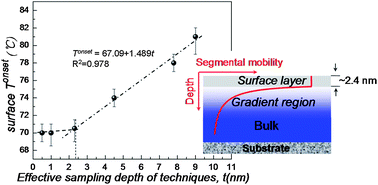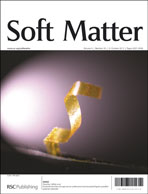We investigated the segmental mobility distribution at the poly(methyl methacrylate) film surface within the depth of 9.0 nm, by measuring the surface reorganization of fluorinated tracer-labeled PMMA using three different surface-sensitive techniques with various analytical depth capabilities, including contact angle measurements, sum frequency generation (SFG) vibrational spectra and angle-resolved X-ray photoelectron spectroscopy (XPS). The onset temperature of fluorinated chain end reorganization (Tonset) at various depths was identified and is shown to depend on the sampling depth of the techniques. The Tonset was verified to be related to the segmental relaxation of PMMA. Plotting the Tonset against the sensing depth of the corresponding technique, the distribution of surface Tonset within a 9.0 nm depth was obtained. An approximately 2.4 nm surface layer with depth-independent Tonset was found, below which the Tonset increased with increasing depth. The depth profile of Tonset effectively divides a film into three layers: a “surface layer” with Arrhenius dynamics on the uppermost film surface, a “gradient region” layer underneath the top layer transporting “liquid-like” dynamics into the internal film, and the remaining bulk layer. This observed depth profile of the surface dynamics may suggest that the polymer chains near the surface adopt an oblate conformation and have lowered entanglements.

You have access to this article
 Please wait while we load your content...
Something went wrong. Try again?
Please wait while we load your content...
Something went wrong. Try again?


 Please wait while we load your content...
Please wait while we load your content...